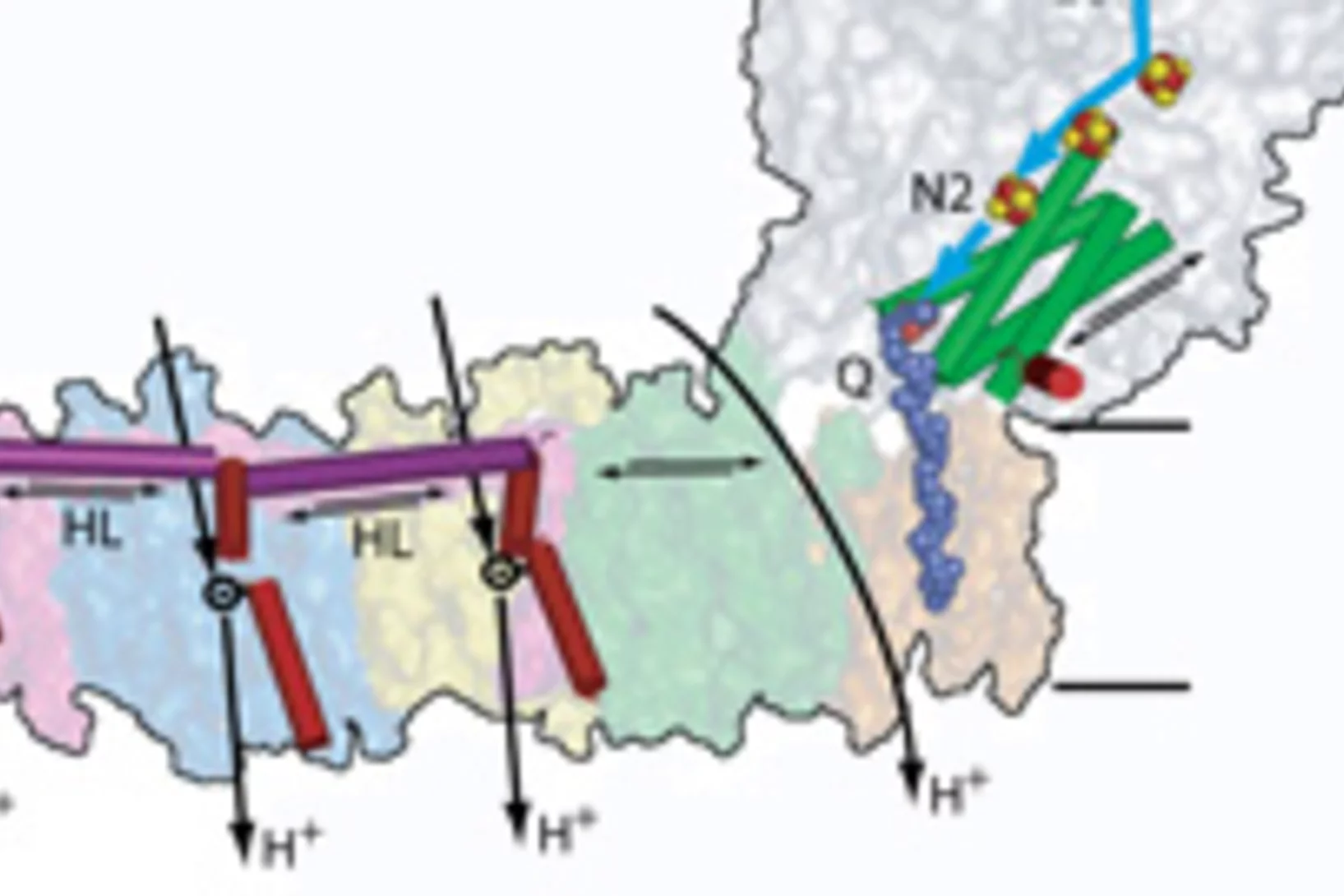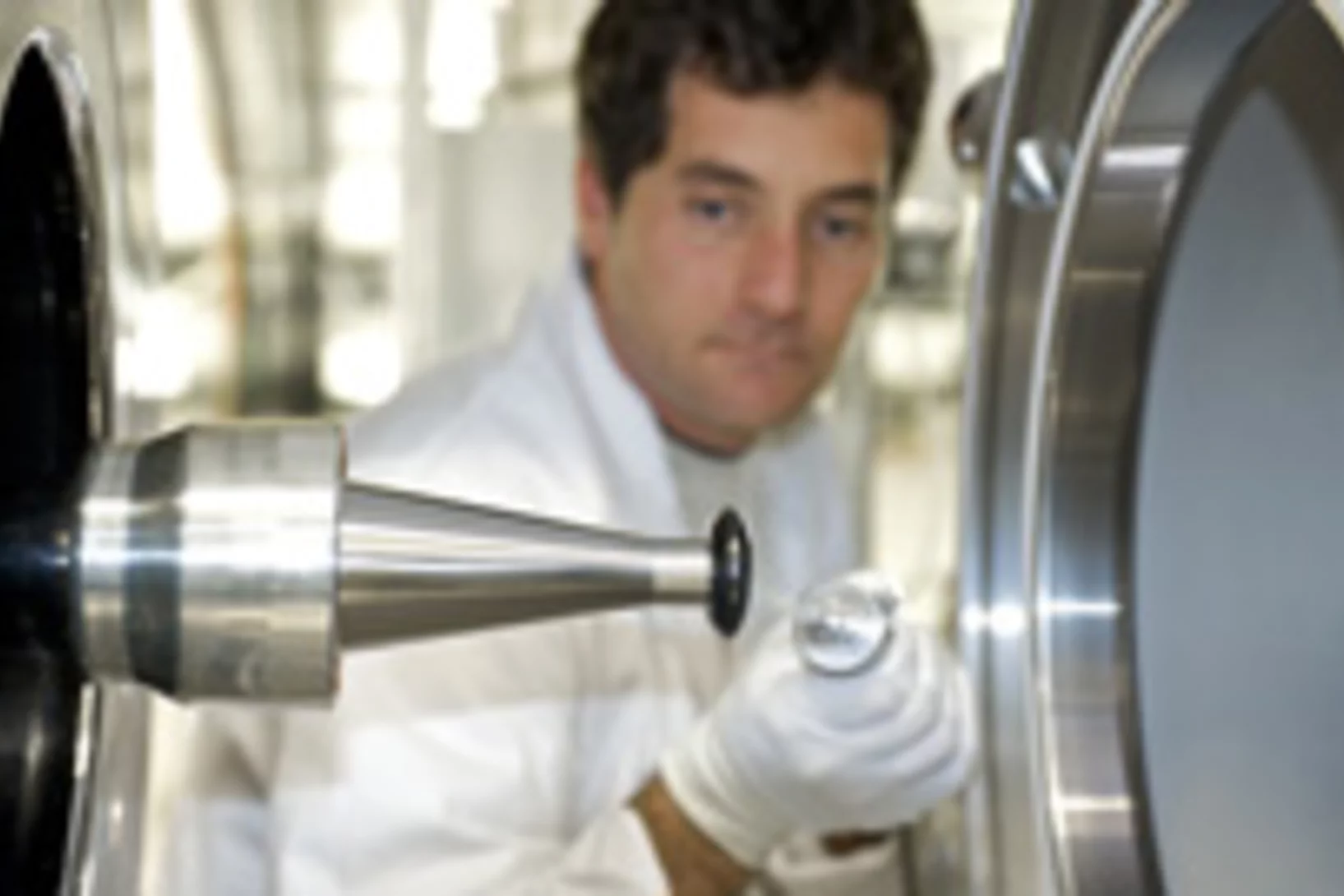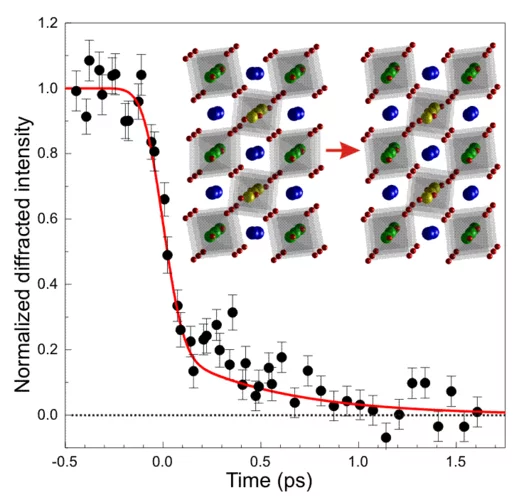
Die jüngste Grossforschungsanlage des PSI erzeugt sehr kurze Pulse von Röntgenlicht mit Lasereigenschaften. Damit können Forschende extrem schnelle Vorgänge wie die Entstehung neuer Moleküle bei chemischen Reaktionen verfolgen, die detaillierte Struktur lebenswichtiger Proteine bestimmen oder den genauen Aufbau von Materialien klären. Die Erkenntnisse erweitern unser Verständnis der Natur und führen zu praktischen Anwendungen wie etwa neuen Medikamenten, effizienteren Prozessen in der chemischen Industrie oder neuen Materialien in der Elektronik.
Mehr dazu unter Überblick SwissFEL
Paul Scherrer Institut ermöglicht bessere Versorgung der Spitäler mit hochwirksamem Krebsmedikament
Das Paul Scherrer Institut ist für die Behandlung von bestimmten Krebserkrankungen mittels seiner einzigartigen Protonentherapie-Anlage bekannt. Nun hilft das PSI auch bei der Behandlung einer Gruppe von Krebspatienten durch die Herstellung eines Krebsmedikaments. Die erste Patientendosis wurde heute am Zentrum für Radiopharmazeutische Wissenschaften des PSI hergestellt und im Kantonsspital Luzern einem Patienten verabreicht.
Gesamtbundesrat zu Besuch am Paul Scherrer Institut
Der traditionelle Jahresausflug des Bundesrats hat dieses Jahr in die Heimat von Bundespräsidentin Doris Leuthard, in den Aargau, geführt. Mit ihren Ratskolleginnen und Ratskollegen sowie der Bundeskanzlerin und den beiden Vizekanzlern besuchte die Bundespräsidentin am Freitag, 2.Juli 2010 als erste Station das Paul Scherrer Institut, das grösste Forschungsinstitut der Schweiz.
Protonenpumpe sorgt für Energie aus Nahrung und Sauerstoff
Es ist ein zentraler Vorgang des Lebens: Nahrung verbindet sich mit Sauerstoff; dabei wird Energie frei und für unterschiedliche Prozesse im Organismus verfügbar. Mit Hilfe von Untersuchungen an der Synchrotron Lichtquelle Schweiz SLS am Paul Scherrer Institut konnten Forscher einen entscheidenden Teil dieses Vorgangs auf molekularer Ebene erklären.
Schweizer Energieforschung im europäischen Verbund
Paul Scherrer Institut beteiligt sich an europäischer Energieforschungsallianz: Wege zu einer nachhaltigen Energieversorgung zu entwickeln gehört zu den dringendsten technischen Herausforderungen der Gegenwart.
Lösungsansätze zum Schutz des globalen Klimas
Tagung am Paul Scherrer Institut bringt Energiefachleute zusammenAls grösstes Energieforschungszentrum der Schweiz und Sitz des Kompetenzzentrum Energie und Mobilität CCEM lud das Paul Scherrer Institut am 11. Juni zu einer Tagung über Lösungsansätze zum Schutz des globalen Klimas ein. Acht Vorträge von Energieexperten aus Forschung und Industrie zeigten die Vielfalt der Verfahren, die zu einer Reduzierung des CO2-Ausstosses führen könnten. In der anschliessenden Podiumsdiskussion wurde deutlich, was über technische Ansätze hinaus getan werden muss.
Nachhaltige Elektrizität: Wunschdenken oder bald Realität?
Der neue Energie-Spiegel ist da.Nachhaltigkeit ist heute in aller Munde. Kaum ein Begriff wird so oft gebraucht wie auch missbraucht. Der Wunsch nach einer nachhaltigen Entwicklung ist wohl unbestritten, aber was bedeutet das konkret im Energie- und Stromsektor?
The nature of nitrate at the ice surface
Trace contaminants such as strong acids have been suggested to affect the thickness of the quasi-liquid layer at the ice/air interface, which is at the heart of heterogeneous chemical reactions between snowpacks or cirrus clouds and the surrounding air. We used X-ray photoelectron spectroscopy (XPS) and electron yield near edge X-ray absorption fine structure (NEXAFS) spectroscopy at the Advanced Light Source (ALS) to probe the ice surface in the presence of HNO3 at 230 K.
Spitzenforschung für die Schweizer Industrie
Das Paul Scherrer Institut stellt vor, wie die Industrie von der Forschung des Instituts profitieren kann.Wie können sich Unternehmen durch die Zusammenarbeit mit dem Paul Scherrer Institut PSI einen Wettbewerbsvorteil verschaffen? war die zentrale Frage der heutigen Jahresmedienkonferenz des PSI. Für eine Industrie, die wirklich innovative Produkte anbieten will, ist das PSI als Zentrum der naturwissenschaftlich-technischen Spitzenforschung ein natürlicher Partner.
Rückkehr in die Berufstätigkeit am Paul Scherrer Institut
Erfolgreiches Pilotprojekt für Naturwissenschaftlerinnen und Ingenieurinnen geht nun in die Regelstruktur über.
Einschlägige Studien haben ergeben, dass spätestens nach der Promotion zahlreiche hochqualifizierte Wissenschaftlerinnen und Ingenieurinnen ihre Karriere (vorerst) nicht weiterverfolgen. Deshalb hat das Paul Scherrer Institut vor einem Jahr ein Pilotprojekt ins Leben gerufen.
Die Massnahme hat sich als Erfolg erwiesen und ist nun fester Bestandteil der PSI-Personalpolitik.
Die Massenkonzentration der isländischen Vulkanasche im europäischen Luftraum
Daten des Paul Scherrer Instituts von der Messtation auf dem Jungfraujoch liefern wichtige Erkenntnisse.Die Eruption des isländischen Vulkans Eyjafjallajokull hat das Fliegen in grossen Teilen Europas zum Erliegen gebracht. Die Entscheide beruhten vor allem auf Modellrechnungen. Wie gefährlich ist nun diese Vulkanasche für Flugzeuge?
Forscher am Paul Scherrer Institut erhalten Titularprofessur an der Universität Basel
Das Argovia-Netzwerk des Kantons Aargau macht eine enge Verknüpfung von Aargauer Spitzenforschung und Basler Hochschullehre möglichHeute fanden am Paul Scherrer Institut PSI die Antrittsvorlesungen der neuen Basler Titularprofessoren Thomas Jung und Frithjof Nolting, statt. Jung und Nolting leiten bereits seit mehreren Jahren eigene Forschungsgruppen am PSI.
Kollisionen mit unerreichter Energie dank Technologie aus dem Paul Scherrer Institut aufgezeichnet
Am CERN konnten erstmals Kollisionen von Teilchen mit der höchsten Energie, die Menschen je erzeugt haben, vermessen werden. Sie wurden vom CMS-Experiment am CERN aufgezeichnet, zu dem das PSI eine der Schlüsselkomponenten, den zentralen Pixeldetektor, beigesteuert hat. Unerwartet schnell führten diese Daten nun zur ersten wissenschaftlichen Veröffentlichung – Ergebnis der Zusammenarbeit von 3000 Forschenden und Ingenieuren aus fast 40 Ländern an diesem gigantischen Experiment.
Magnetspeicher der neusten Generation sind 100 000 mal schneller als herkömmliche Festplatten
Computer-Festplatten könnten bald ausgedient haben: Forscher des Paul Scherrer Instituts PSI und der Universität Konstanz haben neuartige Magnetbänder untersucht und gezeigt, dass sie nicht nur sehr hohe Speicherdichten, sondern auch viel schnellere Zugriffszeiten als heutige Speichermedien zulassen. Leiter der Studie war Mathias Kläui, der am 1. April eine von der ETH Lausanne und dem PSI gemeinsam finanzierte Professur antritt.
The competition between organics and bromide at the aqueous solution – air interface as seen from ozone uptake kinetics and X-ray photoelectron spectroscopy
A more detailed understanding of the heterogeneous chemistry of halogenated species in the marine boundary layer is required. Here, we studied the reaction of ozone (O3) with NaBr solutions in presence and absence of citric acid (C6H8O7) under ambient conditions. Citric acid is used as a proxy for oxidized organic material present at the ocean surface or in sea spray aerosol.
Den Lebensnerv des Tumors treffen
Um wachsen zu können, muss ein Krebstumor von Blut- und Lymphgefässen durchzogen sein, die ihn mit Sauerstoff und Nährstoffen versorgen und durch die der in der Zelle entstehende Abfall entsorgt werden kann. Nun wurde ein wesentlicher Mechanismus aufgeklärt, durch den Tumore umliegende Gefässe veranlassen, sich zu verzweigen und in den Tumor hineinzuwachsen. Dieses Wissen kann in Zukunft für die weitere Entwicklung neuer Medikamente verwendet werden, die das Wachstum der Gefässe verhindern und so den Tumor aushungern.
Das PSI füllt ein Vakuum mit einem Vakuum
Einweihung Vakuumlabor im Schülerlabor iLab am Paul Scherrer InstitutIm Beisein der Erziehungsdirektoren der Nordwestschweiz hat das Paul Scherrer Institut heute ein zweites Experimentierthema in seinem Schülerlabor iLab eingeweiht. Das neue Vakuumlabor bietet den Schülerinnen und Schülern weitere spannende Versuche und ergänzt das im April 2008 eröffnete Schalllabor in idealer Weise.
Neues aus der Smogkammer: Mechanismen der Partikelbildung in der Atmosphäre entschlüsselt
Ein Paradigmenwechsel in der Atmosphärenforschung zeichnet sich ab: Anders als bisher gedacht ist nicht allein die Schwefelsäure für die Bildung derjenigen Feinstaub-Teilchen verantwortlich, die erst in der Atmosphäre entstehen. Der Mechanismus konnte ganz neu verstanden werden – dank eines Experiments in der Smogkammer des Paul Scherrer Instituts (PSI).
Local current measurement in PEFC
Major barriers for a successful commercialization of Polymer Electrolyte Fuel Cells (PEFCs) are insufficient lifetime and high cost of platinum catalyst. A comprehensive understanding of aging and transport phenomena on all relevant length scales is a key to improve durability and to reduce precious metal loading. Flow fields as used in PEFCs for the distribution of the reactant gases over the electrode area cause inhomogeneities. The importance of down the channel inhomogeneities has been realized.
Rätsel geknackt: Wie Feinstaub erst in der Luft entsteht
Forschende des Paul Scherrer Instituts, der University of Colorado und 29 weiterer Forschungseinrichtungen aus verschiedenen Ländern haben die Zusammensetzung der organischen Anteile des Feinstaubs für verschiedene Regionen der Welt untersucht und bestimmt, aus welchen Ursprungssubstanzen er sich jeweils bildet. So konnte erstmals geklärt werden, welche Rolle einzelne Bestandteile der Abgase für die Feinstaubbildung spielen.
High-Tech umgeben von Natur pur
Am Paul Scherrer Institut ist alles im grünen Bereich70 Prozent des Firmenareals des Paul Scherrer Instituts PSI in Villigen sind natur-nah gestaltet. Für diese Bemühungen wurde das Forschungszentrum bereits zum dritten Mal mit dem Qualitätslabel der Stiftung Natur&Wirtschaft ausgezeichnet.
Nutzerdienst – Service für die Forschergemeinde
Neutronen, Synchrotronlicht und Myonen sind für Forschende vieler Disziplinen äusserst nützlich. Mit diesen Sonden lässt sich der Aufbau von Kristallen entschlüsseln, sie helfen beim Verständnis magnetischer Vorgänge oder klären Strukturen biologischer Materialien auf. Gleichzeitig ist es mit einem so grossen Aufwand verbunden, diese Sonden zu erzeugen, dass die meisten Forschergruppen am eigenen Institut keine Neutronen-, Myonen- oder Synchrotronlichtquelle vorfinden werden.
Erzeugung von synthetischem Erdgas aus Holz
Forschende des PSI arbeiten an Verfahren, die Holzreste in synthetisches Erdgas umwandeln, welches in öffentliche Gasleitungen eingespeist werden kann. In der Schweiz steht genug Energieholz zur Verfügung, um einige Prozente des Energiebedarfs zu decken. Die Energiegewinnung aus Holz ist CO2-neutral, weil das CO2, das bei der Verbrennung entsteht, sonst beim Verrotten des Holzes freigeworden wäre. Anders als bei der direkten Verbrennung von Holz entsteht bei der Nutzung von synthetischem Erdgas kein gesundheitsschädlicher Feinstaub.
Zuverlässige Materialien für Kernreaktoren
Materialien, die in Kernkraftwerken eingesetzt werden, sind hohen Anforderungen ausgesetzt. Die Sicherheitsstandards bezüglich Materialauswahl, -einsatz und -überwachung sind sehr hoch. Am PSI wird das Verhalten von langzeitig eingesetzten Teilen untersucht. So interessieren sich die Forschenden für die Bedeutung von Spannungsrisskorrosion in Werkstoffen oder die Auswirkung starker radioaktiver Strahlung auf deren Haltbarkeit.
Schweizer Spitzenforschung in Europäischer Grossforschungsanlage
Heute haben die Vertreter von zehn Staaten im Hamburger Rathaus an der Vertragsunterzeichnung für den Bau des European XFEL teilgenommen. Die Schweiz ist am Aufbau der Anlage beteiligt und wird zum Gelingen des Projekts an entscheidenden Stellen mit Know-how beitragen, das am Paul Scherrer Institut entwickelt worden ist.
Observation of a d-wave nodal liquid in highly underdoped Bi2Sr2CaCu2O8+δ
A key question in condensed-matter physics is to understand how high-temperature superconductivity emerges on adding mobile charged carriers to an antiferromagnetic Mott insulator. We address this question using angle-resolved photoemission spectroscopy to probe the electronic excitations of the non-superconducting state that exists between the Mott insulator and the d-wave superconductor in Bi2Sr2CaCu2O8+δ.
Aufbau von Materialien nanogenau untersuchen
Ein neues Mikroskop an der Synchrotron Lichtquelle Schweiz SLS des Paul Scherrer Instituts wird es möglich machen, den Aufbau von Materialien mit bisher unerreichter Auflösung darzustellen. Dazu werden Forschende einzelne Bereiche in einem Material betrachten, die nur wenige Nanometer (millionstel Millimeter) gross sind, und für jeden dieser Bereiche bestimmen, welche chemischen Elemente darin enthalten sind.
Mädchen erleben Naturwissenschaft und Technik
Am Nationalen Tochtertag begleiten Mädchen der 5. bis 7. Schulklasse ihre Mutter oder ihren Vater zur Arbeit. Dabei können sie sich ein Bild machen über deren Tätigkeit am Arbeitsplatz, lernen die Arbeitskolleginnen und -kollegen kennen und erhalten so einen ersten Einblick in die Erwerbswelt.Dass die Berufe auch in einem naturwissenschaftlichen Umfeld nicht ausschliesslich mit Männern besetzt sein müssen, erfahren die Mädchen am Paul Scherrer Institut in Villigen.
Watching atoms move: an ultrafast phase transition
One approach to advance our understanding of the complex interactions between different degrees of freedom in strongly correlated systems is to use time-resolved methods to study the response of a material after it has been driven out of equilibrium. Ultrafast optical techniques have demonstrated considerable potential to unravel the correlations that drive the interesting physics in such materials.
How fast can the lattice symmetry of a solid change?
One approach to advance our understanding of the complex interactions between different degrees of freedom in strongly correlated systems is to use time-resolved methods to study the response of a material after it has been driven out of equilibrium. Ultrafast optical techniques have demonstrated considerable potential to unravel the correlations that drive the interesting physics in such materials.
Chemie-Nobelpreisträger 2009 forscht am Paul Scherrer Institut
Das Paul Scherrer Institut gratuliert Professor Venkatraman Ramakrishnan zum Erhalt des diesjährigen Nobelpreises für Chemie. Ramakrishnan ist langjähriger Nutzer der Synchrotron Lichtquelle Schweiz SLS des Paul Scherrer Instituts und führt hier regelmässig Experimente zur Bestimmung der Struktur von Ribosomen durch, für die er nun den Nobelpreis erhalten hat.






























